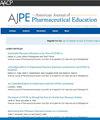An Examination of Mandatory Class Attendance and Academic Performance in a PharmD Program
IF 3.8
4区 教育学
Q1 EDUCATION, SCIENTIFIC DISCIPLINES
引用次数: 0
Abstract
Objective
This study examined the relationship between a mandatory attendance policy (MAP) and grade point average (GPA), grade distribution, and course failures in a PharmD program. Student adherence to the MAP was also analyzed.
Methods
A MAP was implemented in the 2021-2022 academic year. Pre- and post-MAP course grades were collected retrospectively, along with post-MAP attendance records and violations for MAP nonadherence. Due to curricular revisions, grade analyses were restricted to the first and third years.
Results
Analysis of covariance revealed significant main and interaction effects of MAP and curriculum on unweighted GPA. Specifically, unweighted third-year GPA increased by 0.21 points post-MAP, while unweighted first-year GPA increased by 0.11 points. The MAP had a greater impact in the third year than in the first, as indicated by the significant interaction effect. For weighted GPA, analysis of covariance revealed a significant main effect for MAP but no significant main effect for curriculum or interaction effect. Specifically, the aggregate first- and third-year weighted GPA increased significantly by 0.14 GPA post-MAP. For final grades in third-year courses, the failure rate decreased significantly from 1.04% pre-MAP to 0.31% post-MAP, and likewise for first-year courses, from 3.14% pre-MAP to 1.73% post-MAP. Grade distributions improved at both the upper and lower ends post-MAP. Student adherence to the MAP in the 2 academic years following its implementation ranged from 93.2% in fall 2021 to 79.6% in spring 2023.
Conclusion
The implementation of a MAP warrants consideration by schools and colleges of pharmacy seeking to improve students’ academic performance.
药学博士课程的必修课出勤率和学业成绩考试。
目的:本研究探讨强制出勤政策(MAP)与药学博士课程的平均绩点(GPA)、成绩分布和课程不及格之间的关系。描述了学生对MAP的遵守情况。方法:在2021-2022学年实施MAP。回顾性地收集了MAP前后的课程成绩,以及MAP前后的出勤记录和违反MAP的行为。由于课程修订,成绩分析仅限于一年级和三年级。结果:协方差分析(ANCOVA)显示,ap和课程对未加权GPA有显著的主效应和交互效应。具体来说,map后,未加权的三年级GPA提高了0.21分,未加权的一年级GPA提高了0.11分。基于显著的交互效应,MAP在第三年的影响大于第一年。对于加权GPA, ANCOVA结果显示,MAP的主效应显著,而课程和互动的主效应不显著。具体来说,在map之后,第一年和第三年的总加权GPA显著增加了0.14个GPA点。对于第三年课程的最终成绩,不合格率从map前的1.04%显著下降到map后的0.31%,同样,对于一年级课程,不合格率从map前的3.14%显著下降到map后的1.73%。这两年,在map之后,分数分布的上端和下端都有所提高。在MAP之后的两个学年中,学生的MAP依从性从2021年秋季的93.2%到2023年春季的79.6%不等。结论:为了提高学生的学习成绩,实施MAP是值得药学院校考虑的。
本文章由计算机程序翻译,如有差异,请以英文原文为准。
求助全文
约1分钟内获得全文
求助全文
来源期刊
CiteScore
4.30
自引率
15.20%
发文量
114
期刊介绍:
The Journal accepts unsolicited manuscripts that have not been published and are not under consideration for publication elsewhere. The Journal only considers material related to pharmaceutical education for publication. Authors must prepare manuscripts to conform to the Journal style (Author Instructions). All manuscripts are subject to peer review and approval by the editor prior to acceptance for publication. Reviewers are assigned by the editor with the advice of the editorial board as needed. Manuscripts are submitted and processed online (Submit a Manuscript) using Editorial Manager, an online manuscript tracking system that facilitates communication between the editorial office, editor, associate editors, reviewers, and authors.
After a manuscript is accepted, it is scheduled for publication in an upcoming issue of the Journal. All manuscripts are formatted and copyedited, and returned to the author for review and approval of the changes. Approximately 2 weeks prior to publication, the author receives an electronic proof of the article for final review and approval. Authors are not assessed page charges for publication.

 求助内容:
求助内容: 应助结果提醒方式:
应助结果提醒方式:


